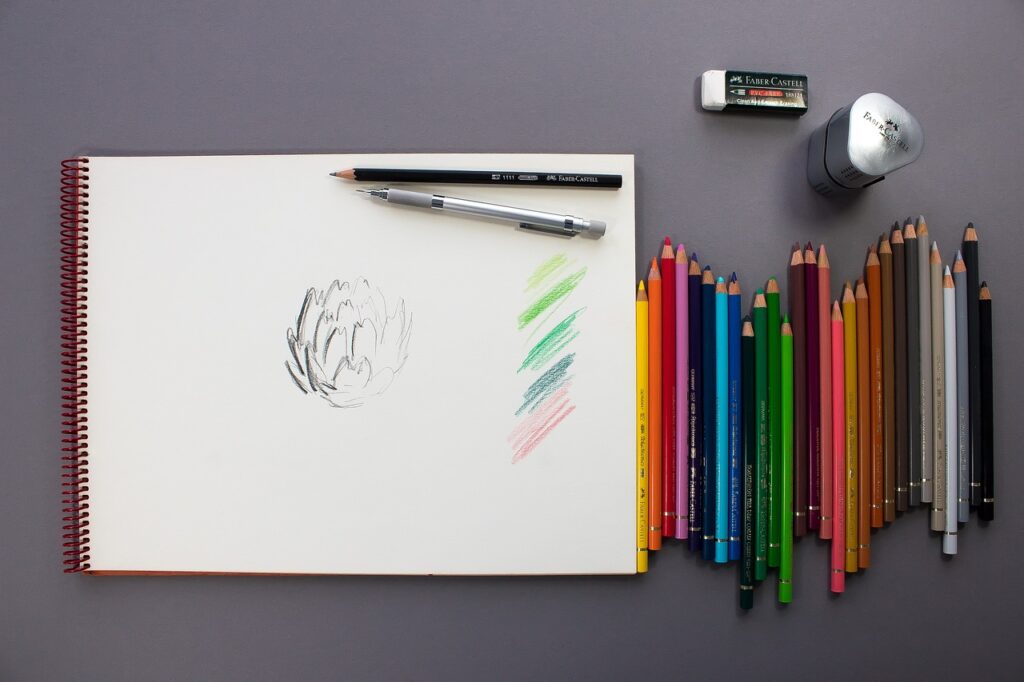Graphic design is a crucial form of visual expression in a variety of fields, from digital marketing to product design and beyond. For those just starting out in this vibrant world, grasping the fundamentals of graphic design is vital. This guide aims to accompany you in your first steps, offering an authoritative and forward-looking perspective on the discipline.
Understanding principles fundamentals graphic design is essential, as they serve as a universal language for visual designers. Just as the rules of grammar are indispensable in the art of writing, design principles are the tools that enable you to structure and communicate your ideas effectively.
Understanding graphic design
What exactly is graphic design? It's an art with a function: using images, typography and space to solve problems and communicate ideas. It's a field where functionality and aesthetics converge to produce memorable experiences and clear messages.
The Fundamental Elements
Each graphic creation is based on basic elements, which are the building blocks of the visual composition. These include linethe shapethe colorthe texture, l'spaceand the typography. Each of these elements must be chosen and used wisely to build a clear visual hierarchy and convey a precise message. As an expert, understanding their individual and collective influence is key to developing designs that capture attention and communicate effectively.
Guiding Principles
Beyond the basic elements, there are the principles that guide their organization. These includealignmentthe contrastthe rehearsalthe proximityand thebalance. A mastery of these principles will enable you to create designs that are not only aesthetically pleasing, but also structured in such a way as to facilitate the viewer's understanding. Used correctly, they form the backbone of effective visual communication and optimal user experience.
Function before form
One of the great adages of graphic design is that function takes precedence over form. This means that priority should always be given to the utility and purpose of the design, rather than to aesthetics alone. A wise designer knows that the beauty of a design lies in its ability to solve a problem or communicate an idea intuitively, without sacrificing clarity for ornamentation.
The Importance of Innovation
As we move through the world of graphic design, the importance of innovation and constant evolution cannot be underestimated. Trends develop and reinvent themselves, and keeping abreast of these changes not only helps you stay relevant, but also a pioneer in the field. Integrating cutting-edge techniques and technologies into your design practice is essential to producing work that stands out and sets tomorrow's standards.
These concepts form the foundation on which a novice graphic designer can build their capabilities and broaden their understanding of the field. With an authoritative, insightful and forward-thinking approach, this guide aspires to equip tomorrow's designers with practical knowledge and innovative solutions, while inspiring commitment and confidence in their creative potential.
Basic principles of graphic design
Before plunging into the heart of graphic creation, getting to grips with the key principles is essential for anyone aspiring to excel in the field of graphic design. More than just rules, these principles serve as a foundation for visual composition, enabling designers to structure their work in a coherent and aesthetically pleasing way. They guide the decision on how and where to place each element to maximize visual impact and message clarity. As we explore these principles, keep in mind that they are the designer's most valuable allies, providing a framework for creativity and innovation while ensuring that functionality is never compromised.
Balance
Balance is the principle whereby the elements of a design are distributed in such a way as to create a sense of stability in the composition. It's not just a question of symmetry, but also of harmony between elements of different visual weight. Designers can play on symmetrical balance, for a sense of formality and order, or asymmetrical balance, which uses contrasts and variations to create dynamic and interesting compositions. The key is to make the design feel complete and coherent, with each part contributing to a unified whole, without any one element unfairly dominating over the others.
Contrast
Contrast is essential in graphic design to separate and prioritize the elements of a composition. It's not limited to opposing colors, but also encompasses differences in size, shape and texture. Using contrast can create a focal point, drawing the viewer's eye to what's most important, or convey a message more effectively. Successful design uses contrast to guide the user through content, highlighting key aspects and making it easier to read and understand. It's a powerful tool for visually communicating the differences and relationships between elements in a way that's both intuitive and aesthetically pleasing.
Alignment
Alignment is a fundamental principle of graphic design, helping to create a coherent, orderly structure within a composition. This involves arranging elements so that they align with common lines or axes, facilitating smooth visual navigation through the design. Good alignment not only aligns elements with each other, but also encompasses how these alignments interact with the composition's margins and white space.
In practice, alignment helps to organize information logically, making content more accessible and easier to digest. For the designer, mastering the art of alignment means being able to guide the viewer's eye intuitively, reinforcing visual communication without resorting to superfluous elements.
Repeat
Repetition is a key principle in graphic design, serving to unify and reinforce the visual coherence of a composition. This concept is not limited to the simple repetition of the same element, but encompasses the repeated use of styles, colors, shapes and patterns throughout the design. By strategically repeating certain aspects, the designer creates a visual rhythm that makes it easier for the viewer to recognize and remember the message.
Repetition also helps to organize information, guiding the eye through the design in a fluid and logical way. Properly executed, it links the various components of the design, ensuring a harmonious, integrated visual experience. It's essential for designers to use repetition wisely to avoid monotony and maintain visual interest.
Proximity
Repetition is a key principle in graphic design, serving to unify and reinforce the visual coherence of a composition. This concept is not limited to the simple repetition of the same element, but encompasses the repeated use of styles, colors, shapes and patterns throughout the design.
By strategically repeating certain aspects, the designer creates a visual rhythm that makes it easier for the viewer to recognize and remember the message. Repetition also helps to organize information, guiding the eye through the design in a fluid, logical manner. Properly executed, it links the various components of the design, ensuring a harmonious, integrated visual experience. It's essential for designers to use repetition wisely to avoid monotony and maintain visual interest.
Hierarchy
Hierarchy is a fundamental principle in graphic design, structuring information according to its order of importance. It guides the viewer's eye through a composition in a logical manner, facilitating understanding of what is essential and what is secondary. By manipulating the size, color, contrast and placement of elements, a designer can clearly communicate the desired reading order. This ensures that the most important message is seen first, followed by the supporting details. Creating an effective visual hierarchy is crucial to capturing the viewer's attention and improving information retention, making visual communication not only aesthetically pleasing but also functional.
Espace Blanc
White space, often overlooked by novices, is actually a powerful element in graphic design. It's not simply a matter of featureless voids, but a crucial component that contributes to the balance and clarity of a composition. White space offers a visual respite, allowing the viewer's eyes to rest and facilitating the digestion of information.
It also plays a decisive role in the hierarchization of information, helping to distinguish and highlight the main elements of the design. Used properly, white space creates a cleaner interface, improves legibility and elevates the overall look of a piece. In short, it's not just a background, but an essential strategic tool for effective visual communication.
Consistency
Consistency, or coherence, is a vital aspect of graphic design, ensuring uniformity and recognition throughout. It allows viewers to quickly become familiar with the visual style and brand, reinforcing the overall message and visual identity. This applies to the consistent use of colors, font types, patterns and visual styles, which must complement and reinforce each other.
An optimal approach helps establish a fluid, predictable user experience, where each element works harmoniously with the others. For a designer, maintaining rigorous consistency is essential to building viewer confidence and ensuring effective visual communication. It is therefore crucial to define precise style guides and stick to them throughout the design process to achieve a visual consistency that amplifies the impact of the design.
Each principle is an essential part of a design's structural integrity. A good graphic designer must not only understand them, but also know how to apply them competently in his or her projects. This requires critical thinking, practice and a willingness to experiment to discover what works best in each specific context. Our guide will continue to support you on this learning adventure, providing expert advice and innovative perspectives.
Application in Design
Let's consider how these principles come to life in concrete designs. Take a website: a balanced layout helps users navigate intuitively, while the contrast between call-to-action buttons and background captures their attention. The alignment of titles, text and images perpetuates a fluid, orderly experience. And the repetition of certain patterns or colors throughout the site reinforces brand identity.
L'judicious use of white space in website design is not to be overlooked. It's one of the most effective tools in the service of clarity, highlighting and emphasizing the most important elements. Think of the user arriving on your page: an overcrowded space will overwhelm them, while a skilfully organized space will invite them to stay and explore. The breathing space provided by white space around headings, text and visuals contributes to a soothing, focused user experience, making it easier to digest information and leading the eye naturally to the focal points you wish to highlight.
Visit consistency across different substrates is also crucial to a brand's visual identity. Whether it's a website, mobile app or printed material, maintaining design consistency reinforces brand recognition and builds trust with the user. This translates not only into the consistent use of the same color palette and fonts, but also into rigorous adherence to layout templates and graphic styles, ensuring a consistent, professional experience regardless of the point of contact.
The role of hierarchy in the user experience should not be underestimated. An intuitively discernible visual hierarchy directs users seamlessly through content, helping to quickly identify the most crucial information. In web design, this manifests itself in headline scale, font weight and visual organization, which together create a clear path for the eye, simplifying navigation and enriching interaction with content.
By applying these principles expertly and thoughtfully, the designs you produce will not only serve functional objectives, but also elevate the user experience to a higher level. A good design is one that resonates with the audience, enabling them to interact with content naturally and effectively. Our guide continues to provide you with strategies for mastering these essential elements, enriching your palette of skills to excel in the sphere of graphic design.
Evolving through Fundamental Principles of Graphic Design
Your exploration of graphic design is just beginning. As you practice and continue to explore, you'll become adept at manipulating principles fundamentals graphic design. Keep in mind that every project is a chance to refine your technique. We encourage you to experiment boldly and discover new ways of incorporating these fundamental principles into your work.
With our advice, based on in-depth expertise and forward-looking vision, you're well equipped to march towards excellence. Believe in your potential for growth and in your ability to influence the field of graphic design.











